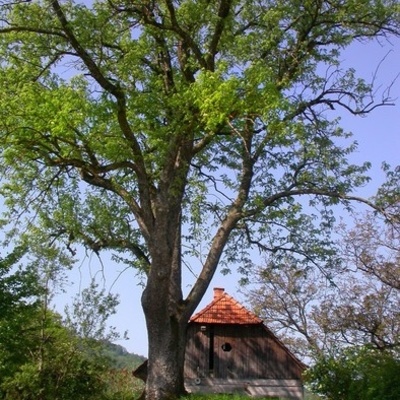The Mraz Witty Pear has reigned at the Žaler homestead for about 200 years and with its 18 m height and trunk thickness of 102 cm when measured at chest level is a true sight. May it continue to gaze over the Kozjansko Hills and delight visitors with its beauty and magnificence for a long time. In 2011 the Slovenia Forest Service named it the "Tree of the Year" in the Celje area and on this occasion issued a special poster and a postcard.
Even a few decades ago the witty pear was often regarded as the ”house tree”, reigning in the yards of homesteads in the Kozjansko region. The witty pear needs a lot of light and warmth and is common in wine growing regions. The witty pear tree has a wide spread-out crown and dark brown furrowed bark. Without leaves, it looks like the must pear from Carinthia. When its leaves, similar to those of the mountain ash turn green, it proudly reveals that it is a special, but unfortunately also a
very rare and unknown wild fruit tree. Its fruits are round and reminiscent of tiny pears or apples. They are about 3 cm in length and weigh 20 g. At first, they are green, but upon maturing in autumn, they turn yellow or red and are sometimes speckled. Unripe fruits have a distinctly bitter taste, caused by the large quantity of phenol. The fully ripened fruits turn brown and become mellow.
The fruits of the witty pear are used for making jams and are usually mixed with apples, pears and quinces. Since the fruits contain a good amount of tannic acid, tannins and antioxidants, witty pear fruits used to be added to the must or wine as a natural ingredient contributing to the protection and improved taste of these beverages. Dried witty pear fruits are very effective in the prevention of intestinal diseases. Today, the ripe fruit is usually mashed and ground into a mush, from which
fruit brandy with an excellent and extremely characteristic aroma is made.
The witty pear is a deciduous tree, and does contain resin. But it once had resin, a household resin! The witty bear lost its important preservative role when winegrowers began using sulphur to prevent opacity and ensure the sustainability of wine in the summertime. The witty pear slowly disappeared in wine growing areas due to its small pit and very poor germination. The germ of the witty pear is very sensitive and subject to attack by fungi, so the germination of seedlings from seed is very
difficult. The stately old trees alongside vineyard cottages were prone to the “wheelwright curse”, as their wood is extremely hard, tough and hard to cleave. At the same time, the wood is flexible and easy to process. All of these properties are best suited for the manufacture of wooden spindle presses. When producing new presses, wheelwrights cut now the nearby witty pear tree, while the owners didn’t plant any new ones, thus leading to the disappearance of these trees from our
regions.









